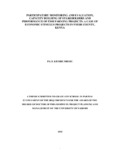| dc.description.abstract | This study sought to establish the mediating influence of capacity building on the relationship between the PM&E and the performance of fish farming projects in Nyeri County in Central Kenya. The specific objectives were: to examine the extent to which stakeholder participation in M&E during project design influences the performance of fish farming projects; to assess the extent to which stakeholder participation in M&E during project implementation influences performance; examine the extent to which stakeholder participation in utilization of M&E results influences the performance; determine how the combined influence of PM&E influences the performance, and to establish the mediating influence of capacity building on the relationship between PM&E and the performance. This study adopted a pragmatic research paradigm for a mixed research method in a concurrent research design. The study targeted all the eight fish farming projects funded by the ESP programme in Nyeri County and the sample size was calculated based on Yamane (1967) formula. The study adopted both probability and non-probability sampling techniques. The sample size is 271 respondents comprising of 247 farmers, 8 project managers and 56 committee members from a population of 653 stakeholders. Structured questionnaires were administered to collect quantitative data from selected farmers, focus group discussions were conducted to collect qualitative data from the constituency project management committee members while interviews were administered to project managers. The instruments were tested for validity and reliability through the content validity index (CVI=0.833) and the Cronbach Alpha’s internal consistency index (a=0.795) for reliability. Pearson’s correlation and regression models were used to analyse quantitative data while qualitative data was analysed using content analysis. The study found out that the level of stakeholder participation during project design was average (M=3.38), average during implementation (M=3.45) and average during utilization of M&E results (M=3.43) .The study established a significant influence of stakeholder participation in M&E during project design (t=10.02, p<0.05), during implementation (t=10.07, p<0.05), in utilization of M&E results (t=8.38, p<0.05) and combined PM&E (t=10.88, p<0.05) on performance of fish farming projects. Further, capacity building had a partial mediating influence on the interaction between PM&E and performance of fish farming projects. The study recommends that fish farming projects should increase the level of stakeholder participation in M&E at all stages of PM&E ranging from project design, implementation and utilization of M&E results so as ensure capacity building and consequently project performance. The study provides a capacity building model for strengthening the relationship between PM&E and performance of fish farming projects. | en_US |

